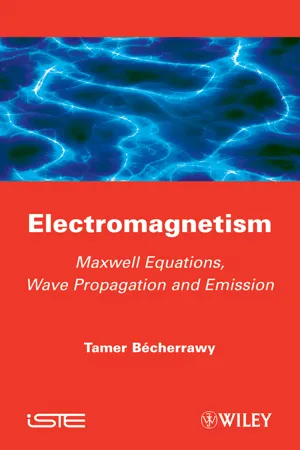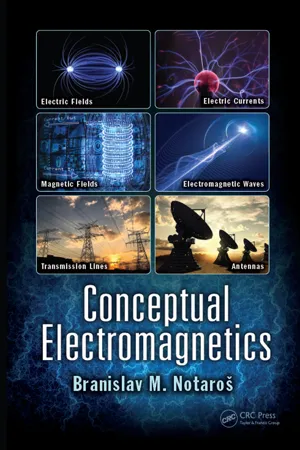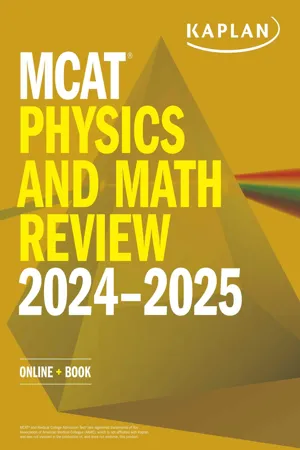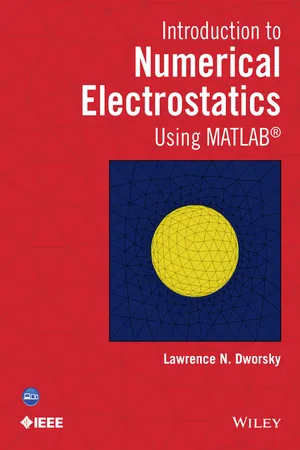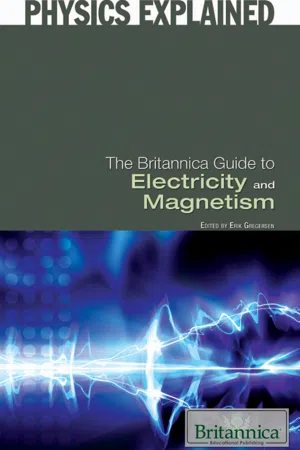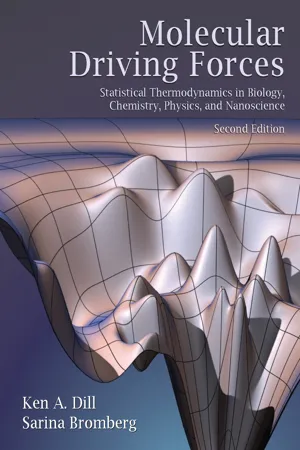Physics
Electrostatics in Vacuum
Electrostatics in vacuum refers to the study of stationary electric charges and the forces they exert in a vacuum, where there is no air or other matter. This branch of physics focuses on the behavior of electric fields and the interactions between charged particles in a vacuum environment. Understanding electrostatics in vacuum is essential for various applications in technology and engineering.
Written by Perlego with AI-assistance
Related key terms
Related key terms
1 of 4
Related key terms
1 of 3
11 Key excerpts on "Electrostatics in Vacuum"
- eBook - ePub
- Anupam Garg(Author)
- 2012(Publication Date)
- Princeton University Press(Publisher)
3 Electrostatics in VacuumWith this chapter we begin our study of electrodynamics proper. We consider the simplest possible situation, static electric charges, and how they interact, the electric field and potential they produce, and the accompanying work and energy concepts.A special situation arises when these static charges reside on conducting bodies. This situation is of great practical importance and is often studied along with the general problem of electrostatics. We expect that the reader has seen at least an elementary treatment of electrostatics in the presence of conductors, and so we defer it to chapter 14 , after we have covered the key concepts of vacuum electrodynamics.12 Coulomb’s law
It is an empirically established fact that two point charges q 1 and q 2 that are held fixed at positions r 1 and r 2 , respectively, exert equal and opposite forces on each other.1 The force on charge 2 is given bywhere is the unit vector from r 1 to r 2 .Equation (12.1) is Coulomb’s law. In the Gaussian system, the unit of charge is determined once units for force and distance are chosen. This unit is called the electrostatic unit (esu) or statcoulomb; it is such that two charges of 1 esu each repel each other with a force of 1 dyne at a separation of 1 cm. In the SI system, the unit of charge is called the coulomb (C), and the constant is such thatFurther,The charge of an electron is −4.8 × 10−10 esu or −1.6 × 10−19 C.The electric field at a point due to a set of charges is defined as the ratio of the force on a test charge at the point to the value of the test charge:If the test charge is an extended body, then one must also invoke a limiting procedure in which the test charge is assumed to become vanishingly small. Since we have written the force law for point particles to begin with, this limit is automatic. Thus, the field at a point r due to a charge q - eBook - ePub
Electromagnetism
Maxwell Equations, Wave Propagation and Emission
- Tamer Becherrawy(Author)
- 2013(Publication Date)
- Wiley-ISTE(Publisher)
Chapter 2Electrostatics in Vacuum
The interaction of electric charges, as expressed by Coulomb force, is formulated according to the Newtonian concept of action-at-a-distance: if a charge q′ is produced at r′ at a time t′, a charge q located at r feels the action of q′ instantaneously, whatever the distance |r − r′| and the medium that separates the charges. The concept of field was developed by Faraday, Maxwell, Lorentz, Einstein, and many others. In modern physics, all interactions are conceived as local, i.e. involving quantities defined at the same point r and at the same time t. Fields are physical entities that are endowed with energy, momentum, etc., and they may propagate with some finite speed as waves. Furthermore, in quantum theory, the same objects (electrons for instance) have both particle and wave properties.In this chapter, we introduce the concepts of electric field and potential, we derive the fundamental equations of Electrostatics in Vacuum, and we discuss some of their properties and the concept of electrostatic energy.2.1. Electric forces and fieldIn a famous experiment, Coulomb used a torsion balance to measure the force of interaction of electric charges. He verified that a small charge q1 acts on a small charge q2 situated at a distance r with a force FE = Ko q1 q2 /r2 oriented along the line joining the charges. This force is repulsive between like charges and attractive between unlike charges. It has a similar mathematical form to Newton's law of universal gravitation To specify both the direction and the magnitude, we write[2.1 ]Coulomb's force obeys the principle of action and reaction. Ko is a constant that depends on the adopted unit of charge. Using the coulomb (C) as the unit of charge and the Heaviside or rationalized system, we write[2.2]εo is the permittivity of vacuum. The factor 4π is introduced to simplify the writing of equations. The electric force is much more intense than the gravitational force and the coulomb is an enormous charge on the human scale: electric sparks are produced by less than one microcoulomb and rubbing produces a charge of the order of the nanocoulomb per square centimeter - eBook - ePub
- Branislav M. Notaroš(Author)
- 2017(Publication Date)
- CRC Press(Publisher)
ELECTROSTATIC FIELD IN FREE SPACE IntroductionElectrostatics is the branch of electromagnetics that deals with phenomena associated with static electricity, which are essentially the consequence of a simple experimental fact – that charges exert forces on one another. These forces are called electric forces, and the special state in space due to one charge in which the other charge is situated and which causes the force on it is called the electric field. Any charge distribution in space with any time variation is a source of the electric field. The electric field due to time-invariant charges at rest (charges that do not change in time and do not move) is called the static electric field or electrostatic field. This is the simplest form of the general electromagnetic field, and its physics and mathematics represent the foundation of the entire electromagnetic theory. On the other hand, a clear understanding of electrostatics is essential for many practical applications that involve static electric fields, charges, and forces in electrical and electronic devices and systems.1.1 Coulomb’s LawCoulomb’s law states that the electric force Fe12 on a point charge Q2 due to a point charge Q1 in a vacuum or air (free space) is given by1 (Figure 1.1 )F=e 1214 πε 0Q 1Q 2R 2( C o u l o m b ′ s l a w ) .R ^12(1.1) With R12 denoting the position vector of Q2 relative to Q1 , R = |R12 | is the distance between the two charges,is the unit vector2 of the vector R12 , and ε0 is the permittivity of free space,=R ^12R 12/ Rε 0= 8.8542 pF / m (permittivity of free space) .(1.2) By point charges we mean charged bodies of arbitrary shapes whose dimensions are much smaller than the distance between them. The SI (International System of Units) unit for charge is the coulomb (abbreviated C), while the unit for force (F - No longer available |Learn more
MCAT Physics and Math Review 2024-2025
Online + Book
- (Author)
- 2023(Publication Date)
- Kaplan Test Prep(Publisher)
CHAPTER 5ELECTROSTATICS AND MAGNETISM
In This Chapter
Insulators and Conductors5.1 ChargesElectric Field5.2 Coulomb’s Law5.3 Electric Potential Energy5.4 Electric PotentialEquipotential Lines Electric Dipoles5.5 Special Cases in ElectrostaticsMagnetic Fields Magnetic Forces5.6 MagnetismConcept SummaryCHAPTER PROFILE
The content in this chapter should be relevant to about 7% of all questions about physics on the MCAT. This chapter covers material from the following AAMC content category:4C: Electrochemistry and electrical circuits and their elementsIntroduction
Electrostatics is the study of stationary charges and the forces that are created by and which act upon these charges. Without electrical charge, we would not be able to do many of the activities that we enjoy or consider essential to basic living. But living with electrical charge can also be dangerous and even deadly: magnify the small shock you receive from a doorknob after walking across a carpet, and you have the equivalent of a lightning bolt strong enough to stop a heart. This same concept can be used in life-saving therapy as well: cardioversion and defibrillation create a strong electrical current through the heart’s conduction system that attempts to resynchronize a pulse.In this chapter, we will review the basic concepts essential to understanding charges and electrostatic forces including conductors and insulators. We will review Coulomb’s law, which describes the attractions and repulsions between charged objects. Next, we will describe the electric fields that all charges create, which allow them to exert forces on other charges. After we’ve discussed how charges set up these fields, we’ll observe the behavior of charges that are placed into these fields. In particular, we will note the motional behavior of these test charges inside a field in relation to the electrical potential difference, or voltage, between two points in space. We can then determine the change in electric potential energy as the charge moves from a position of some electric potential to another. Next, we will describe the electric dipole and solve a problem involving one of the molecular dipoles most important to life on this planet: the water molecule. Finally, we will explore the topic of magnetic fields and forces. - Lawrence N. Dworsky(Author)
- 2014(Publication Date)
- Wiley-IEEE Press(Publisher)
1 A Review of Basic ElectrostaticsElectric and magnetic phenomena, including electromagnetic wave propagation, are described by Maxwell’s equations.1 When nothing is changing with time, that is, when all derivatives with respect to time are zero, the electric and the magnetic phenomena decouple and become separate electric and magnetic phenomena. These are referred to respectively as electrostatics, which describes the properties of systems with separated static regions of positive and negative electric charge (although the entire system is charge-neutral), and magnetostatics, which describes the properties of systems with electric currents and/or magnetized materials.In this book we shall consider only electrostatics. This subset of a subset of topics describes a vast number of real-world situations. Chapter 2 describes some practical needs and uses of electrostatic analyses, the remainder of the book will be dedicated to examining several techniques for performing these analyses.The materials to follow are intended to be a quick review of the relationships that will be used throughout this book. The intent here is to provide a consistent set of notation using all the relationships that will be needed going forward. Many of these relationships are stated without derivation or proof. A more complete electrostatics theory text is recommended for newcomers to the subject. There are very many excellent texts available. The references list at the end of this chapter is certainly not exhaustive, but the texts cited are considered standards in the field.1.1 Charge, Force, and the Electric Field
Electric charges exert forces on one another. This is the basis of electrostatics. The characteristics of these forces are summarized in Coulomb’s law:- Electric charge carries a polarity, or sign. The choice of sign was originally arbitrary, but now is established by tradition—the electron, the most common charged subatomic particle, carries a negative charge.
- Britannica Educational Publishing, Erik Gregersen(Authors)
- 2010(Publication Date)
- Britannica Educational Publishing(Publisher)
CHAPTER 2 ELECTRICITYT he phenomenon associated with stationary or moving electric charges is called electricity. Electric charge is a fundamental property of matter and is borne by elementary particles. In electricity the particle involved is the electron, which carries a charge designated, by convention, as negative. Thus, the various manifestations of electricity are the result of the accumulation or motion of numbers of electrons.ELECTROSTATICS
Electrostatics is the study of electromagnetic phenomena that occur when there are no moving charges—i.e., after a static equilibrium has been established. Charges reach their equilibrium positions rapidly because the electric force is extremely strong. The mathematical methods of electrostatics make it possible to calculate the distributions of the electric field and of the electric potential from a known configuration of charges, conductors, and insulators. Conversely, given a set of conductors with known potentials, it is possible to calculate electric fields in regions between the conductors and to determine the charge distribution on the surface of the conductors. The electric energy of a set of charges at rest can be viewed from the standpoint of the work required to assemble the charges; alternatively, the energy also can be considered to reside in the electric field produced by this assembly of charges. Finally, energy can be stored in a capacitor. The energy required to charge such a device is stored in it as electrostatic energy of the electric field.ELECTRIC CHARGEElectric charge is a basic property of matter carried by some elementary particles. Electric charge, which can be positive or negative, occurs in discrete natural units and is neither created nor destroyed.Electric charges are of two general types, positive and negative. Two objects that have an excess of one type of charge exert a force of repulsion on each other when relatively close together. Two objects that have excess opposite charges, one positively charged and the other negatively charged, attract each other when relatively near.- eBook - ePub
- Samarendra Kumar Biswas, Umesh Mathur, Swapan Kumar Hazra(Authors)
- 2021(Publication Date)
- CRC Press(Publisher)
The process of electrification (e.g., by rubbing glass with silk) is caused by the movement of electrons. In an uncharged body, atoms are electrically neutral, i.e., the total negative charge on the electrons is equal to the total positive charge on the atomic nuclei. Electrons are free to move, for example, during rubbing or when a body is placed in an electric field. An excess of electrons in a body, relative to its neutral state, means that the body is negatively charged. Similarly, a deficit of electrons relative to a neutral state means that the body is positively charged. The magnitude of the charge is expressed in coulombs (C).When the properties of flowing (current) electricity were discovered, the term static came into use to distinguish an electric charge that was at rest from one that was in motion. Today the term static electricity is used to describe phenomena from an electric charge, regardless of whether the charge is at rest or in motion.3 Streaming current or charging current (expressed in amperes) is defined as the flow rate of charge into a given system per unit of time. It is the current caused by the rate of flow of charged material into a system; it should be distinguished from the rate of static charge generation within a batch system, such as during the rubbing of solids or stirring of liquids.Static electricity involves high potentials, generally of the order of kilovolts, and very low currents, generally in the range of milliamperes (mA). Therefore, static electricity effects are associated with an electric field, but unlike current electricity, static electricity has no significant magnetic field effects.Earth is a near-infinite “reservoir” of electrons and is conventionally referred to as having zero potential. Therefore, if a charged conductor is electrically connected to the earth, its potential becomes zero. Earthing also removes all charge from a conductor unless there is another charged body in its vicinity that influences by induction.Bodies with unlike charges attract each other, and those with like charges repel. Based on Coulomb’s law, if two bodies (that are small compared to the distance between them), having charges Q 1 and Q 2 coulombs, are placed in vacuum at a distance of r (m) between them, then the force F - No longer available |Learn more
- Robert A. Pelcovits, Joshua Farkas(Authors)
- 2023(Publication Date)
- Barrons Educational Services(Publisher)
10Electrostatics
Learning Objectives
In this chapter, you will learn:Coulomb’s lawPrinciple of superpositionElectric fields and field linesElectric potential and voltageCalculating the potential due to a continuous charge distributionFinding the electric field given the potentialCalculating the electric field due to a continuous charge distributionWe begin our study of electric and magnetic phenomena by considering the interaction of stationary point electric charges. This is easy to do if we go back to Chapter 9 and replace the words gravitational force with electric force, and mass with charge. That’s right—the physics and math behind stationary point electric charges and universal gravitation are just about the same, with the exception that in gravitation there are no repulsive forces.Coulomb’s Law
The magnitude of the force between two point charges Q1 and Q2 separated by a distance R is given by the equationScalar part of Coulomb’s lawTIPNote the similarity with Newton’s law of universal gravitation, Chapter 9 .The direction of the force is along the line between the two charges. Like charges repel, while unlike charges attract.Coulomb’s law, like Newton’s law of universal gravitation, is an experimental result. However, it does make sense that the force increases with increasing charges and decreases with increasing distance between charges.ε0 is a constant called the permittivity of free space and is given ε0 = 8.85 × 10− 12 C2 /N · m2 . From your physics class, you may also be familiar with Coulomb’s law written in the form F = k|Q1 Q2 |/R2 , where k is called the electrostatic constant and has a value of k = 1/4πε0 = 8.99 × 109 N · m2 /C2 . ε0 - eBook - ePub
Introduction to Electromagnetism
From Coulomb to Maxwell
- Martin J N Sibley(Author)
- 2021(Publication Date)
- CRC Press(Publisher)
2 Electrostatic FieldsMost of us are familiar with the phenomenon of electrostatic discharge: lightning strikes, sparks from nylon clothing and sparks from nylon carpet. It may be thought that the study of static electric fields has little to offer the electrical engineer. After all, we are taught that electrons flow in conducting materials, and so why should we concern ourselves with the study of static charges? However, as we shall see later in this chapter, electrostatics introduces several ideas that will be very helpful when we consider capacitors and, ultimately, transmission lines.2.1 Coulomb’s Law
As we have seen in Chapter 1 , electronic charge comes in two forms: negative charge from an electron and positive charge from a proton. In both cases, a single isolated charge has a charge of 1.6 × 10−19 Coulomb. If there are two charges close to each other, they tend to repel each other if the charges are alike or attract each other if they are dissimilar. Thus, we can say that these charges exert a force on each other.Charles Augustin de Coulomb (1736–1806) determined by direct experimental observation that the force between two charges is proportional to the product of the two charges and inversely proportional to the square of the distance between them. In terms of the SI units, the force between two charges, a vector quantity, is given bywhereF =(2.1)rq 1q 24 π εr 2- F is the force between the charges (N)
- q 1 and q 2 are the magnitudes of the two charges (C) ε is a material constant (F m−1 )
- r is the distance between the charges (m)
- and r is a unit vector acting in the direction of the line joining the two charges – the radial unit vector
This is Coulomb’s law. The force, as given by Equation (2.1), is positive (i.e. repulsive) if the charges are alike, and negative (i.e. attractive) if the charges are dissimilar (see Figure 2.1 ). As Equation (2.1) shows, the force between the charges is inversely dependent on a material constant, ε - Nima Gharib, Javad Farrokhi Derakhshandeh, Peter Radziszewski(Authors)
- 2022(Publication Date)
- Elsevier(Publisher)
Chapter 3: Fundamentals of electrodynamics
Abstract
This chapter focuses on the fundamentals of electrostatics for particles. Important ideas and terminologies are introduced for subsequent debate. In addition, we present essential equations and mathematical tools to emphasize the physical nature of the issues. The offered contents in this chapter will serve as a strong basis for investigations into related applications of electrostatics of particles.Keywords
Charge Distribution; Electric Charge; Electromotive Force; Electrostatics of Particles; Farday's Law; Ohm's Law; Tribocharging1. Introduction to electrostatics of particles
The introduction and fundamentals of electrodynamics theory were published by David Griffiths (2021) with a clear and accessible explanation for undergraduate and postgraduate levels in the Fourth Edition. It is good to emphasize that the textbook published by David has been designed with the conceptual difficulties frequently encountered by scholars and researchers, including students and senior researchers, which offer the theoretical phases with carefully selected examples and thorough illustrations. Therefore, the main relative sections of this chapter, which relate to the electrostatics of particles, are chosen from the textbook of Introduction to Electrodynamics (Griffiths, 2021 ). The presented materials in this chapter will serve as a solid foundation for studies of related applications of electrostatics of particles.For the majority of engineering applications, Newtonian mechanics is sufficient. However, when applied to objects moving at high velocities (close to the speed of light), it is incorrect and must be replaced by special relativity (introduced by Einstein in 1905); when applied to extremely small objects (close to the size of atoms), it fails for a variety of reasons and must be replaced by quantum mechanics (developed by Bohr, Schrödinger, Heisenberg, and many others). Because modern particle physics deals with extremely fast and extremely small objects, a mechanics that incorporates both relativity and quantum principles is required, which is known as quantum field theory; it was developed in the 1930 and 1940s but is still not considered a fully satisfactory system today. Therefore, considering some assumptions and simplifications, electrodynamic phenomenon can be considered by classical mechanics. Mechanics describes how a system will act under the influence of a specific force. There are just four fundamental forces that physics is now aware of, which are listed as follows in decreasing order of strength: (1) strong, (2) electromagnetic, (3) weak, and (4) gravitational. Categorizing forces according to the aforementioned list may generate the following questions: Where is the point of contention? Where is the “normal” force that prevents you from collapsing? Where are the chemical forces that connect molecules? Where does the impact force between two colliding billiard balls originate? The explanation is that they are all electromagnetic forces. Indeed, it is not hyperbolic to assert that we live in an electromagnetic world—nearly every force encountered in daily life, with the exception of gravity, is electromagnetic in origin. Because the strong forces that keep protons and neutrons together in the atomic nucleus have an incredibly narrow range, humans do not “feel” them, despite their hundredfold greater strength than electrical forces. Weak forces, which are responsible for some types of radioactive decay, are likewise short-ranged and significantly weaker than electromagnetic forces. Gravity, on the other hand, is so pitifully weak (in comparison to the others) that we only sense it in the presence of massive mass concentrations (such as the earth and the sun). The electrical attraction between two electrons is (10e42- eBook - ePub
Molecular Driving Forces
Statistical Thermodynamics in Biology, Chemistry, Physics, and Nanoscience
- Ken Dill, Sarina Bromberg(Authors)
- 2010(Publication Date)
- Garland Science(Publisher)
21 The Electrostatic Potential We Switch from Fields (Forces) to Electrostatic Potentials (Energies)The electrostatic field, introduced in Chapter 20 , describes forces, which are vector quantities. In this chapter, we switch to the electrostatic potential, which describes energies, which are scalar quantities. We switch for two reasons. First, scalars are easier to use than vectors. Second, our aim in Chapters 22 and 23 is to predict equilibria in systems in which charges play a role. To predict equilibria, we need energies.We also develop here Poisson’s equation. Poisson’s equation simplifies electrostatics calculations in many problems. We will use it in Chapter 22 to compute the energy for moving a charged particle, such as a salt ion or protein, in the vicinity of other charged objects such as proteins, colloids, DNA, polyelectrolytes, membranes, electrodes, or dielectric boundaries.What Is the Electrostatic Potential?The work dw that you must perform to move a charge q through a small distance dℓ in the presence of a fixed electrostatic field E is the negative of the dot product of the force f = qE and the displacement dℓ (see Equation (3.8) ):δ w = − f ⋅ d ℓ = − q E ⋅ d ℓ .(21.1) There is a minus sign in Equation (21.1) because this work is performed against the field, not by the field as in Equation (3.8) . To move a charge from point A to B, the total work wAB is given by the path integral (see Appendix G ),w= − qA Bℓ .∫ A BE ⋅ d(21.2) By equating wAB with the electrostatic energy, we are assuming, according to the First Law of Thermodynamics, processes that involve no heat exchange. In such cases, wAB is the maximum possible work and is called the reversible work
Index pages curate the most relevant extracts from our library of academic textbooks. They’ve been created using an in-house natural language model (NLM), each adding context and meaning to key research topics.
Explore more topic indexes
Explore more topic indexes
1 of 6
Explore more topic indexes
1 of 4

